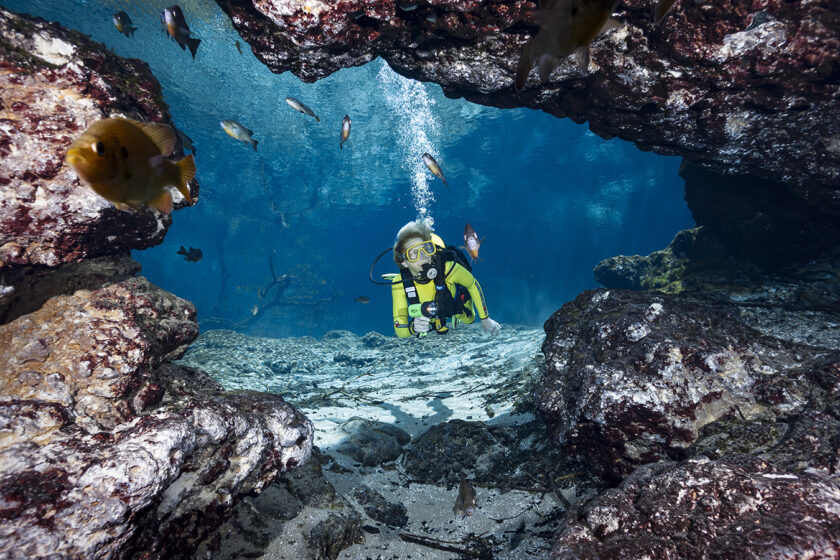The beams of our powerful dive lights probe the dark recesses of the cave throwing shadows helter-skelter down its walls. Then suddenly there is another source of illumination — a single shaft of sunlight flashing against the limestone wall showing us the way out.
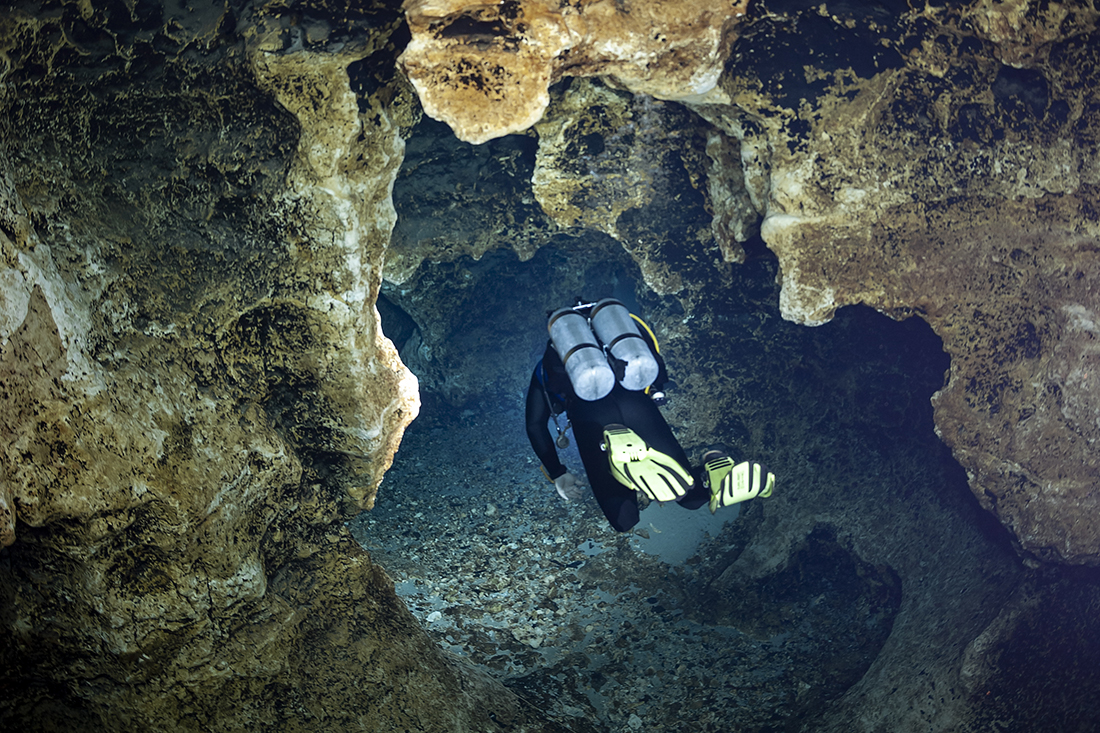
We arrive at a small opening in the cavern’s ceiling and look up. Some 60 feet above, the tannic waters of the Santa Fe River mingle with the clear outflow of the spring, swirling in cloud-like patterns pierced by shafts of sunlight refracted through the mirror-smooth surface above. Through it, branches of the pool’s surrounding tree line are as clearly discernable as the fish now circling in front of my face. It is a surreal scene and one we’ll have ample time to admire, as we’ll be spending another half hour of decompression in the submerged cleft known as the Devil’s Ear.
Nearly two hours after entering the hidden world of Florida’s flooded basement, we are once more back in the realm of sunshine and air. Just two months ago these waters were filled with swimmers and divers of every persuasion. But on this Wednesday in early autumn the spring basin and surrounding parklands are quiet. Taking advantage of the solitude and reluctant to return to land, I spend a few minutes fining around the spring mouth, remembering why I have always been drawn to Florida’s freshwater springs.
Springs of Phenomenal Magnitude
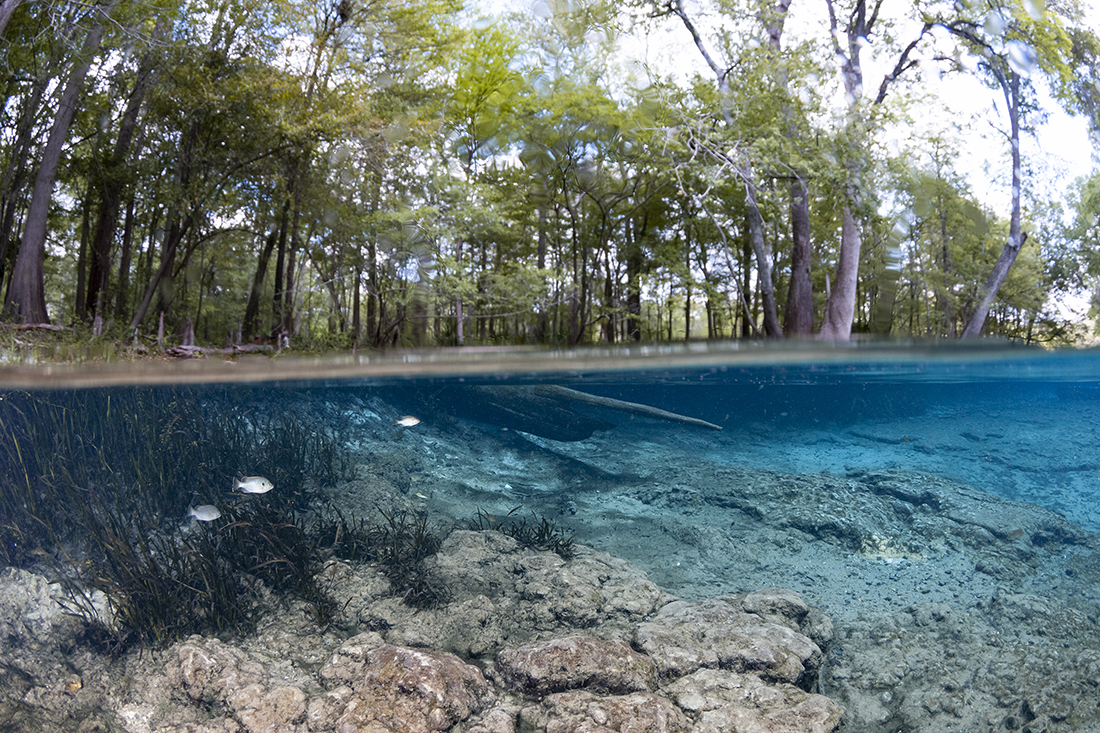
Even in the days before cave diving seemed like a logical idea – just the thought of having millions of metric tons of rock over my head gave me the willies – I was attracted to North Florida’s spring basins and adjoining runs. The pleasure then came from watching aquatic creatures like freshwater turtles, largemouth bass and bream move as if floating in air. How can anyone who peers into the crystalline depths of these freshwater ecosystems not be captivated? The late Marjory Stoneman Douglas, grand dame of Florida environmentalists, likened their azure-tinted pools to “bowls of liquid light.”
Florida is home to a phenomenal number of springs. According to the Florida Geological Survey’s last assessment in 2004, approximately 720 springs dot most of the Upper Peninsula. While more than half amount to little more than a trickle, 33 are of “first magnitude,” with another 191 in the “second magnitude.”
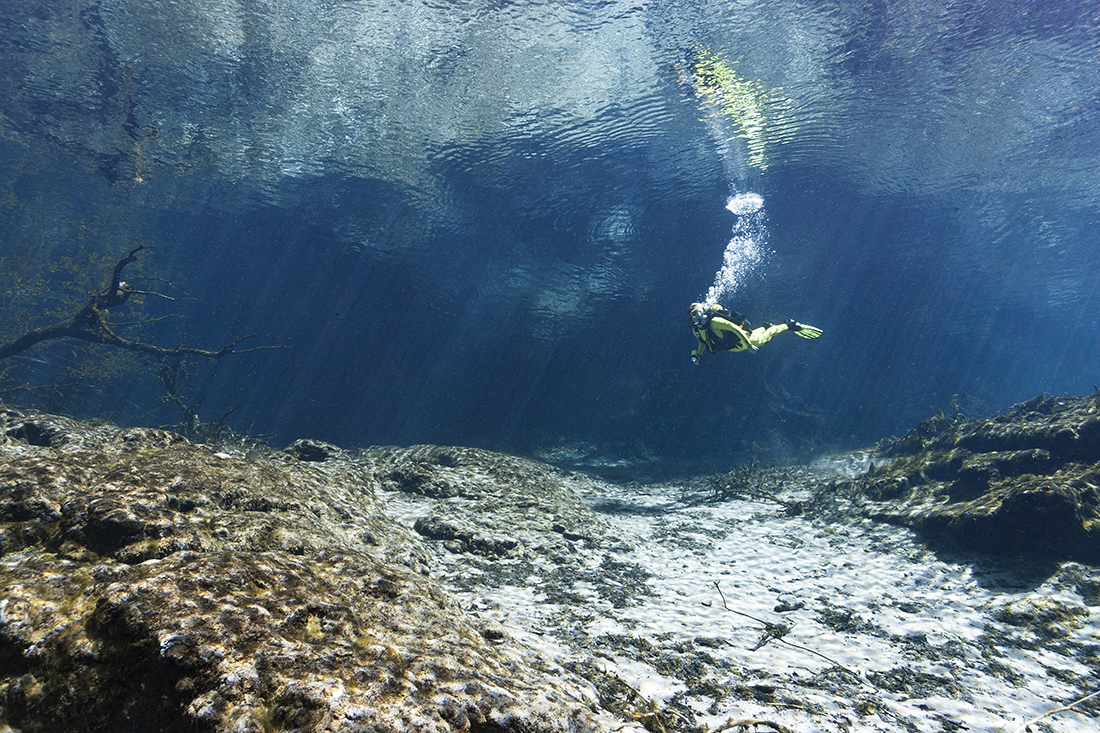
A first magnitude spring is one of artesian origin — meaning water is pushed to the surface by internal hydrostatic pressure in the strata at a rate of or more than 100 cubic feet per second (cfs). Silver Springs, located northeast of Ocala, is ranked among the world’s largest with a measured flow rate of 500 million gallons a day. Comparatively, the Devil’s Eye spring system that we just dove has a discharge rate of over 46 million gallons a day, making it a “middle of the road” second magnitude (10 to 99 cfs.) spring.
The genesis for these underground rivers is a combination of Florida’s porous limestone landform – called karst – and the large quantities of rainfall that soaks in to feed the underground aquifer. In all likelihood that name-brand bottle of “naturally” purified water you purchased with lunch came from Florida.
Fade to Black in the Devil’s Eye & Ear
Every sport has its Mecca; for golfers it’s Augusta. NASCAR fans flock to Daytona.
In the arena of cave and cavern diving, the one coveted most by North America’s technical diving community, for both training and exploration is none other than Ginnie Springs, Devil’s Eye/Ear system.
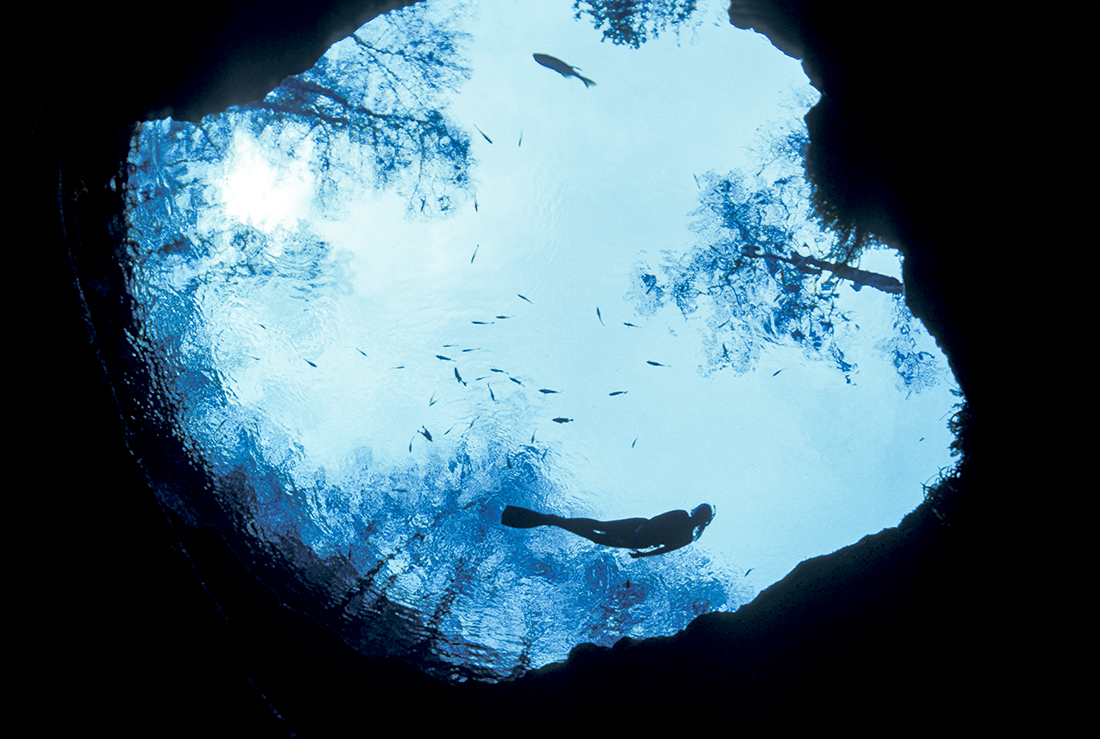
Between the system’s two entrances, the Ear and the Eye, stands not only a domain beyond the ambient-lit world, but the proverbial doorway to Florida’s massive subterranean river system.
Just a few hundred feet from the entrance, branches off towards its artesian source through a series of looping tunnels linked by still more passages that extend more than a mile underground. To date more than 8,000 feet of this expansive network of submarine caves have been explored, surveyed and mapped. Yet, to fully know it would require hundreds of exploratory dives.
Adding to the system’s sheer size, cave divers are exposed to a diverse range of conditions, from large, high-flow conduits to small, low-flow tunnels that demand advanced body control and buoyancy techniques. Giving reason why anyone who is involved in the sport has at one time or another (or soon to be) passed through this north Florida dive park to perform at least some portion of their training here.
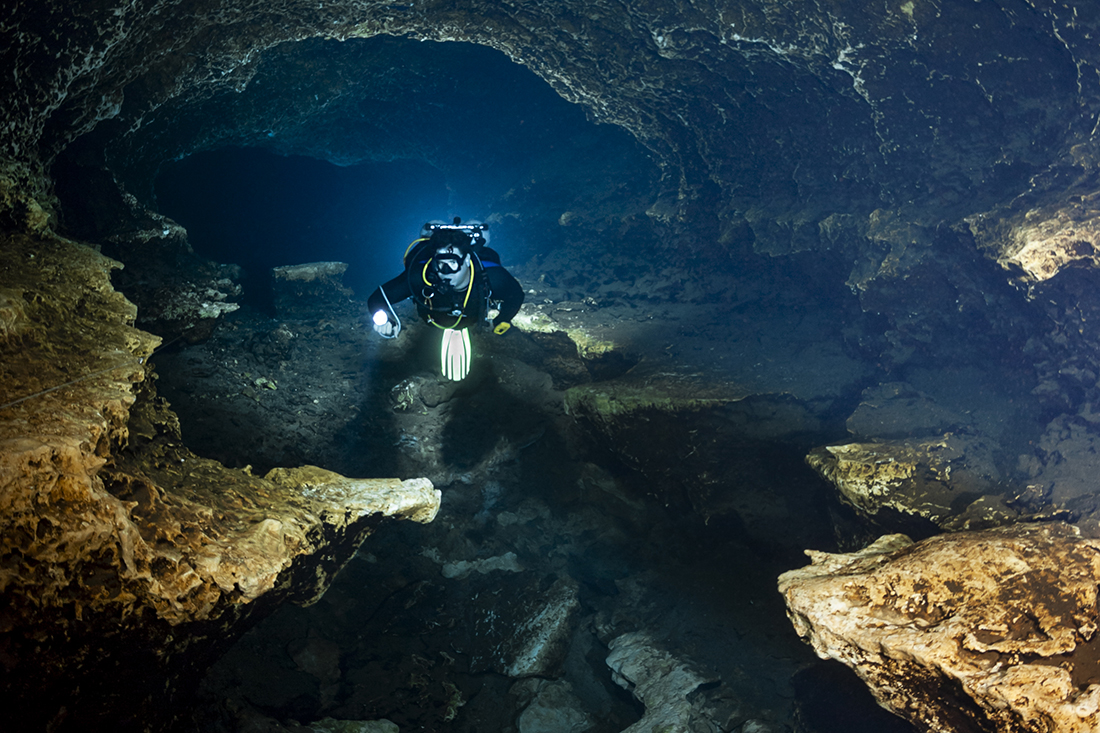
On the cerebral end, winding your way through this warren of tunnels, seeing how eons of water movement have sculpted the Karst limestone bedrock is a bizarre sensation.
Ginnie Springs – Diving for Every Level
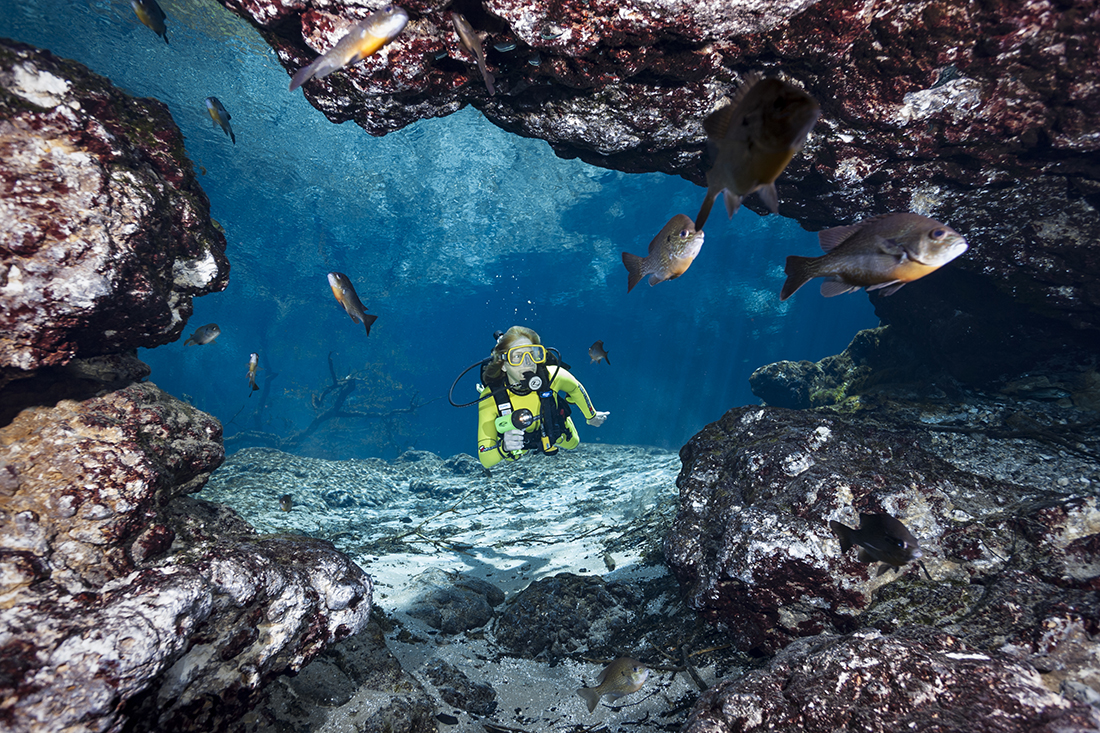
Of course, you don’t have to be into the exoteric sport of underwater spelunking to appreciate Ginnie Springs. Park promoters advertise Ginnie Springs as the world’s most popular freshwater dive site.
Outside the normal run of campers and tubers, this privately-owned, commercialized park north of Gainesville off Interstate 75 and US 27 plays host to one of the most eclectic gathering of divers this side of the globe. Visit in summer and the park may feel more like a zoo – from paddlers with masks and snorkels to serious techies suited up in doubles to fully closed rebreather systems — giving credence to the expression “what separates the men from the boys is the size (or price) of their toys.”
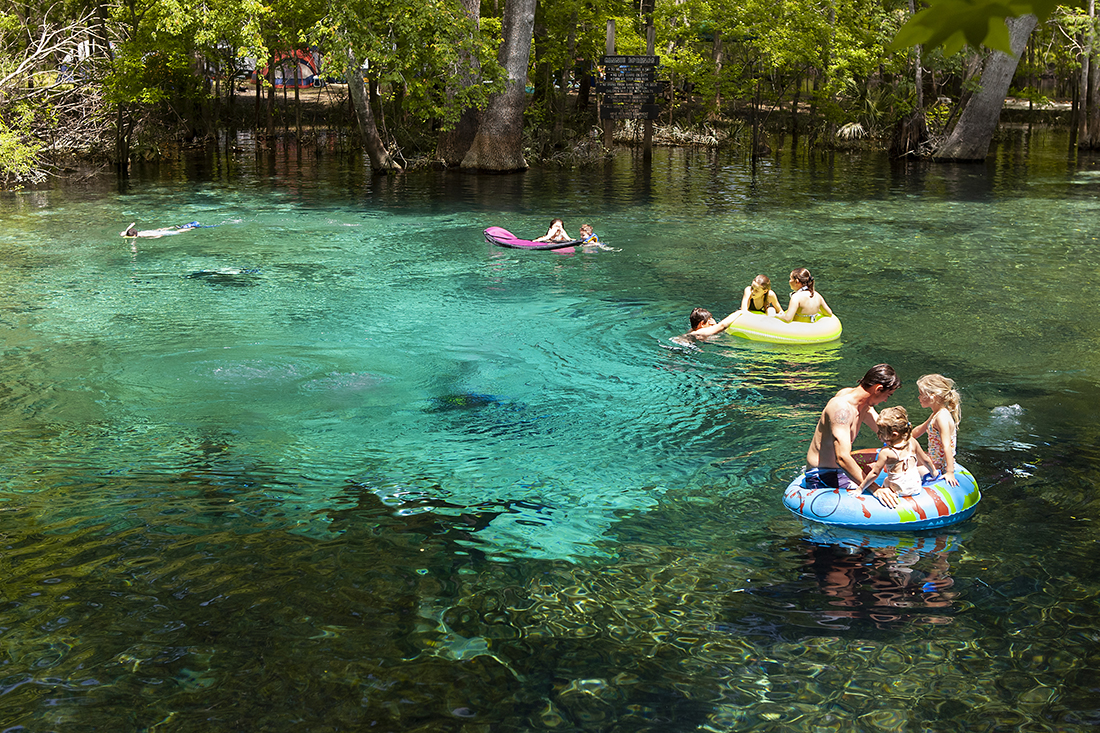
There are many reasons for the park’s popularity, including easy access and ample shore side amenities, spectacular water clarity, and consistency. Water temperatures remain in the low 70s year-round and visibility within the spring vents and caves is seldom hampered by rising flood levels in neighboring rivers. When rivers become swollen after heavy rains, the basin of many north Florida Springs are inundated by tea- colored, tannic-stained waters, reducing visibility to just a few feet. When waters rise the springs at Ginnie are among the last to be affected and, even then, the river water does not affect the primary diving attractions.
Yes, attractions. Plural. The Ginnie’s property actually encompasses two springs of interest to divers. In addition to Devil’s Eye and Ear, the park’s namesake spring is also a second magnitude outflow and the site of one of America’s most famous freshwater dives: The Ballroom.
On weekends due to Ginnie’s dependably clear, calm waters, its main 90-foot diameter, 12-foot deep bowl-shaped basin provides a popular venue for multitudes of open water checkouts. Fed by the spring’s underground cave system, a tree-lined limestone basin provides a swimming pool like environment ideal for orientation and gear checks. Still more people make the trek for the chance to sample the cavern diving experience without the need for special training or equipment.
A Glimpse through the Karst Window
For open water divers, the number one draw in Ginnie’s spring basin is the underground cavern that feeds it.
Not to be confused with cave diving, cavern divers stay within constant visual contact of the cave’s entrance. As cavern dives go, the Ballroom is as safe as it gets, open to anyone with an open-water rating and dive light. From the deep end of the basin divers enter a pair of small but not restrictive openings that lead downward into the Ballroom’s cavern.
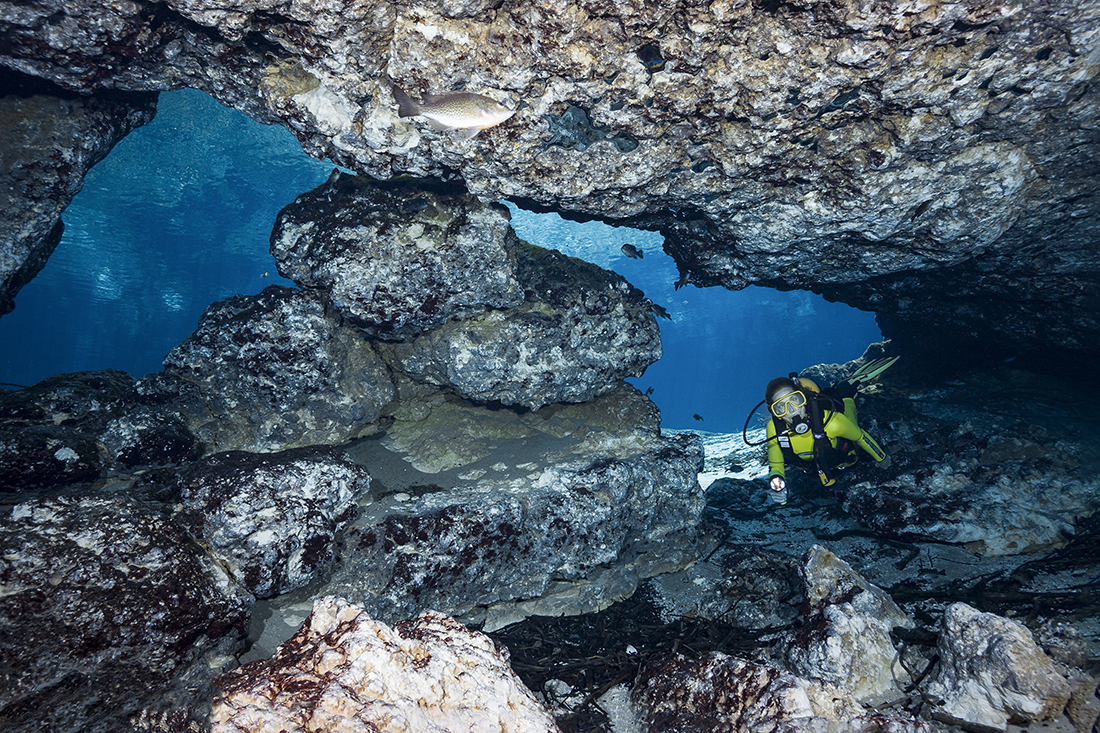
While a large amount of daylight filters in through the entrance, once past it, down around 30 feet, most of the sunlight is lost requiring a light to see any further. Divers entering the Ballroom are required to carry at least one light.
Angling down 45 degrees to a depth of 50 feet the dangerous, maze-like cave system beyond is terminated by a large, welded grate preventing divers from entering. Midway down the chamber reaches its widest point, allowing a dozen or more divers to swim about freely, hence the name Ballroom.
Normally such a scenario would put one beyond even the limits of cavern diving training, but Ballroom represents a special case, and one that allows most all divers to go underground safely. Unlike many caverns, which contain layers of fine silt or clay that can destroy visibility when disturbed, the Ballroom is a combination of hard limestone and heavy sand that, even when kicked up vigorously, settles quickly. With average depths in the 35-to-45-foot range no decompression limits is rarely a concern.
In addition to the permanent iron grating that blocks the passage down into the sub-terrain’s nether world, there are no branching side passages that divers could become lost in. Divers can explore to a depth of 50 feet or so and peer through the grate into the forbidden caverns beyond. But they must remain in the large primary chamber where the way out is always apparent, thanks to a permanent guide rope mounted on the ceiling.
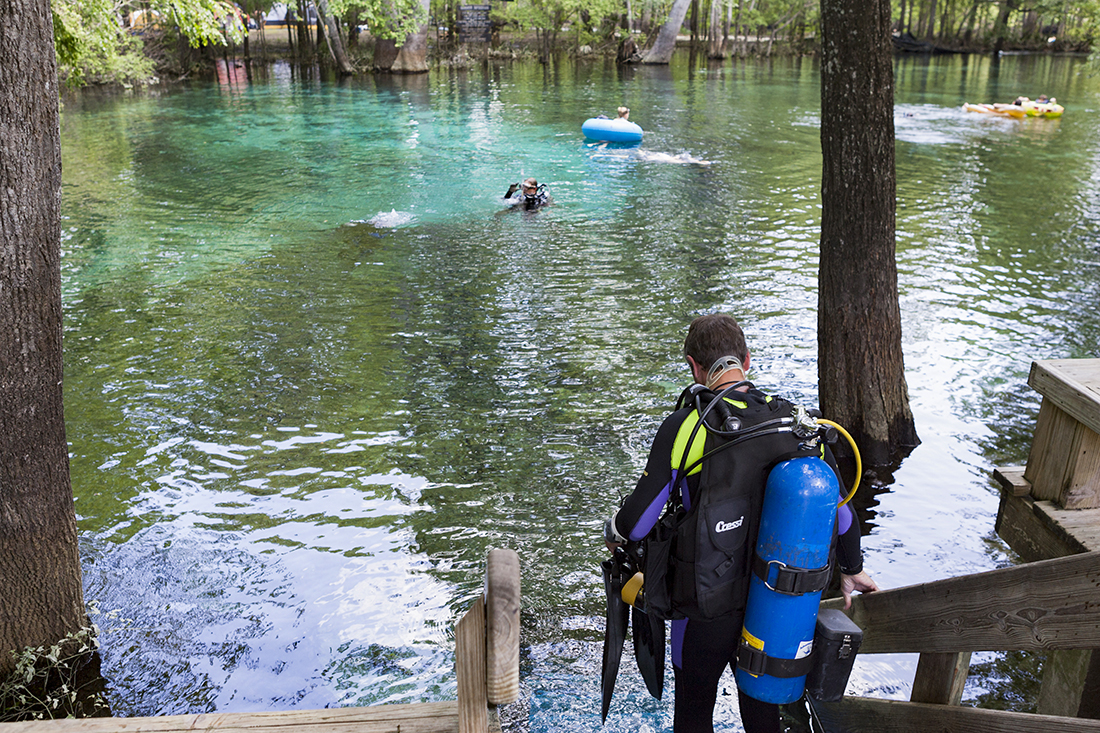
Each year thousands of divers’ experience this. Some prefer looking out through the entrance, or “karst window” as cavers call it, to experience the “bowl of liquid light” affect in the spring basin. Others favor the “in-your-face” sensation of millions of gallons of purified water pouring through the Ballroom’s bottom opening. Yet no matter where you are the sun lit exit is always visible.
As a second dive most open water visitors head over to the park’s other primary spring, the Devil’s Eye system. Here water flowing from one of the region’s most extensive networks of underground tunnels issues forth into the Santa Fe River through a pair of openings known as the Devil’s Ear and Devil’s Eye springs. Also in the vicinity is a third spring vent known as Little Devil, which does not share the same water source but is located within easy swimming distance at the end of a short clear-water channel.
When gearing up to enter the water at this site recreational divers will often find themselves surrounded by dry suit clad technical brethren assembling complex rigs ranging from large sets of double tanks to rebreathers augmented with separate stage tanks, multiple lights, reels to even a DPV. These are cave divers preparing to enter the extensive labyrinth of either Devil’s Eye or Ear.
Doing the Devil’s Eye/Ear, Ginnie Loop
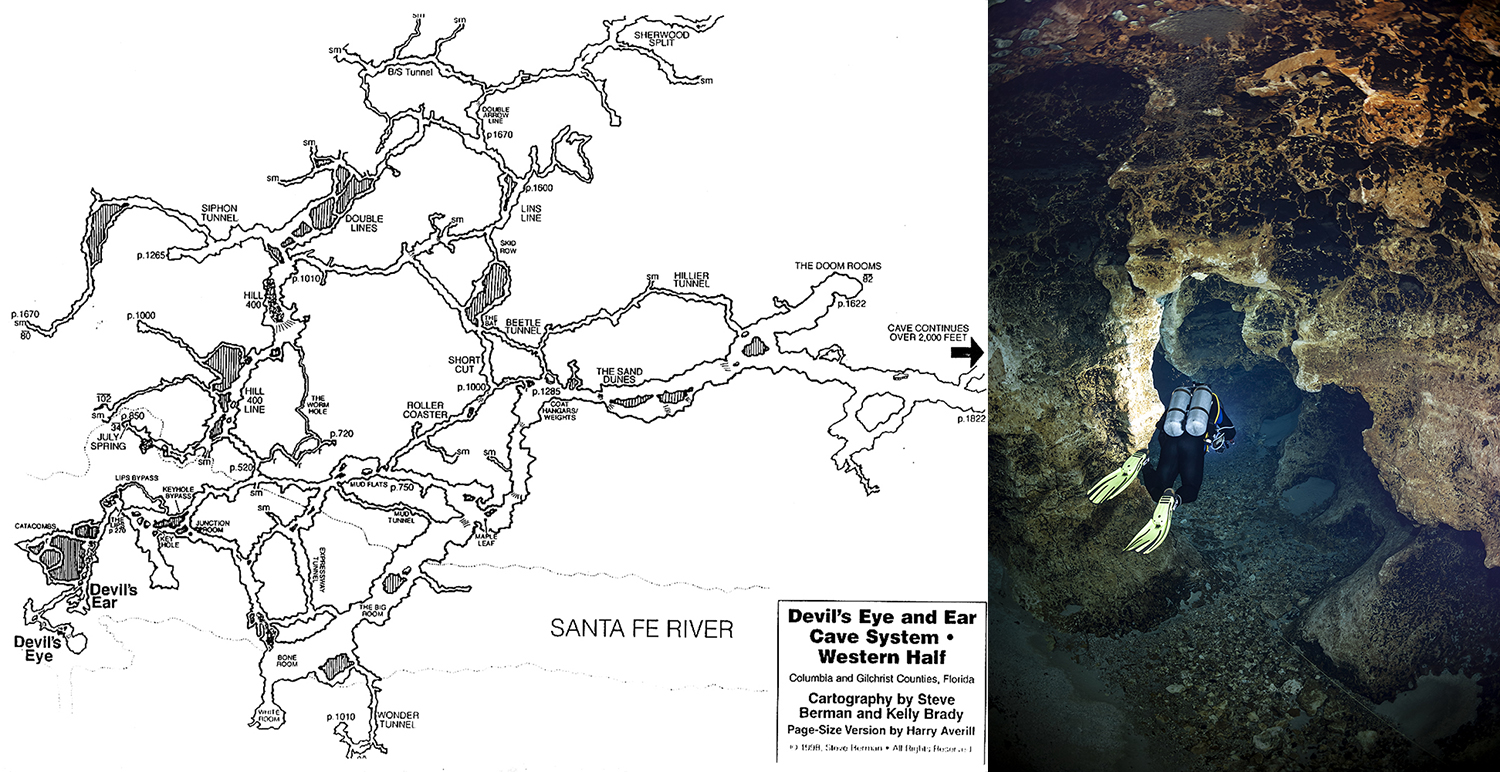
For open water divers a good venue is to enter the water at the stairs closet to the bathhouse, where they can begin by peering into the narrow four-foot-wide fissure of Little Devil.
Following the spring’s shallow run will bring divers to an intersection with the Santa Fe River. Located within the mouth of the spring run, and with typically clear water overhead, lies the circular opening known as the Eye. Divers can drop to a depth of 20 feet or so in this crater-like formation and roll over to admire the Eye’s almost perfectly round opening, or peer into the cave system’s shadowy entrance.
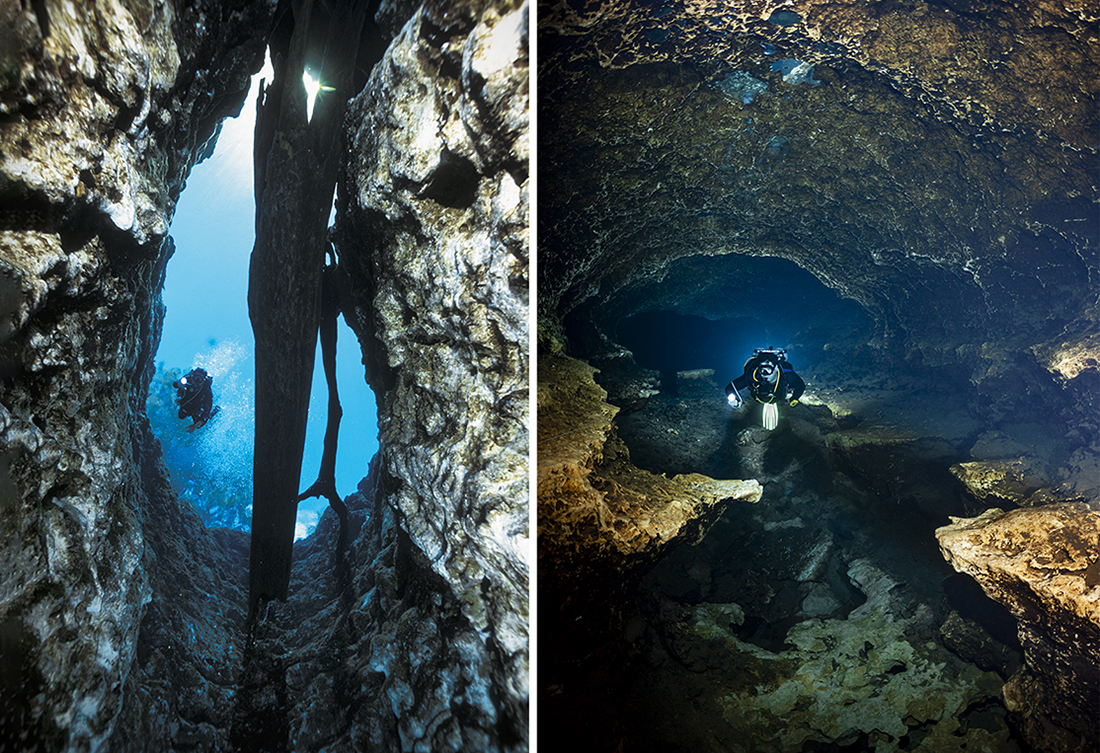
Unlike Ginnie’s Ballroom cavern, beyond the entrance is only permissible for certified cave diving. If you should notice a small cave entrance at the bottom of the Eye stay out! Beyond this opening is a death trap to the untrained and unequipped, where they will easily become disoriented and lost. Ditto for the Ear as well.
A very short distance away, exiting the run into the river, is the irregularly shaped fissure known as the Ear, which drops to a depth of 40 feet. Unlike the Eye the water flow exiting the cave is quite strong and divers who are able to pull or fin their way down to the opening should then be careful – the powerful flow could shoot them upward in an uncontrolled ascent.
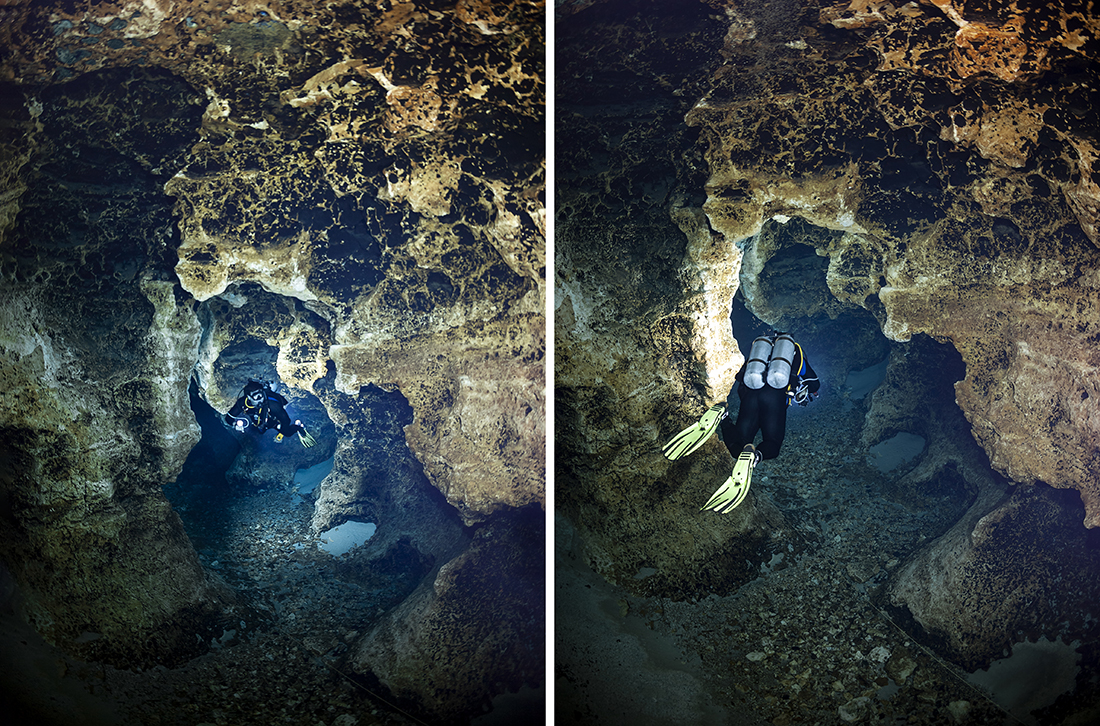
Depending upon the water table and river level, the dark tannic waters of the Santa Fe may be partially or completely obscure the surface of the Ear. The mixing of the clear and tannic water is one of the more visually interesting aspects of this dive, and after satisfying their curiosity by peering into the cave entrance many divers like to spend a few minutes at the upper reaches of the entrance. While doing this they will likely be sharing the space with cave divers who, having finished their underground exploration, must now spend a half hour or more decompressing.
Divers who have brought a surface float can finish their dive by drifting downstream on the Santa Fe. Though the water clarity is nowhere near that of the springs, the river provides the chance to glide over a lunar-like limestone bottom and catch the occasional glimpse of schooling bluegills, bream or mullet, to one the many large, prehistoric- looking alligator garfish that inhabit the river. The dive ends with a short swim up another spring run, which leads back to Ginnie Springs itself where divers can exit the water for a short walk back to their starting point.
Getting Around Spring Country
Located just north of Gainesville, Florida, Ginnie can be either a destination unto itself or a stopover for divers headed to South Florida’s reefs and wrecks.
Your quickest access is off Florida’s Interstate Highway I-75, which runs through the heart of North Florida’s spring country with most of the spring’s connecting access roads off varying exits. To reach Ginnie Springs, exit 404 (from north) or 339 (from south) to High Springs. From High Springs take County Road 340 and go approximately 6.5 miles; a sign indicating the turn off to Ginnie Springs will be on the right.
Following the road to the end is a dirt road turn off to the right. Follow it and you will come the park’s entrance and main structure housing the parks dive center.

In addition to serving as the park’s headquarters, this central structure houses one of the region’s largest and best-equipped dive shops for both recreational and cave diving along with a merchandise concession and deli.
The shop provides high-pressure air fills but does not dispense ntirox. The staff can provide most all other dive-related services, including equipment rental, repair, sales and instruction. Park admission is $32 per day for divers, or $24 per day for Cave Divers.
Equally attractive is the infrastructure build around these springs. With ample parking, dedicated equipment assembly stations and sturdy boardwalks and stairs leading right to the water’s edge, getting into the water couldn’t be easier. Post dive there are warm showers, picnic shelters and grills available for use.
Ginnie Springs – 386-454-7188 www.ginniespringsoutdoors.com

